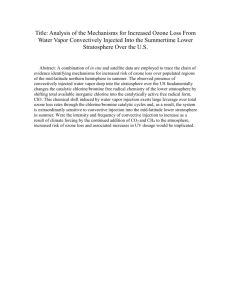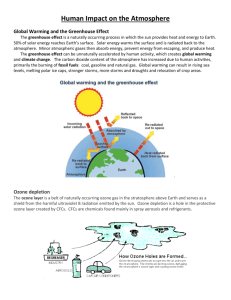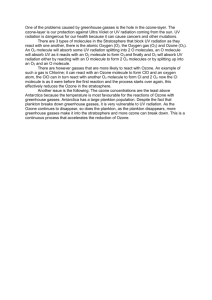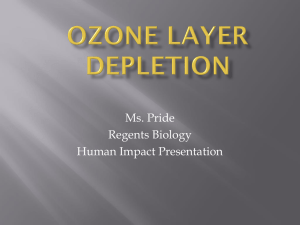Unit IX: Ozone
advertisement
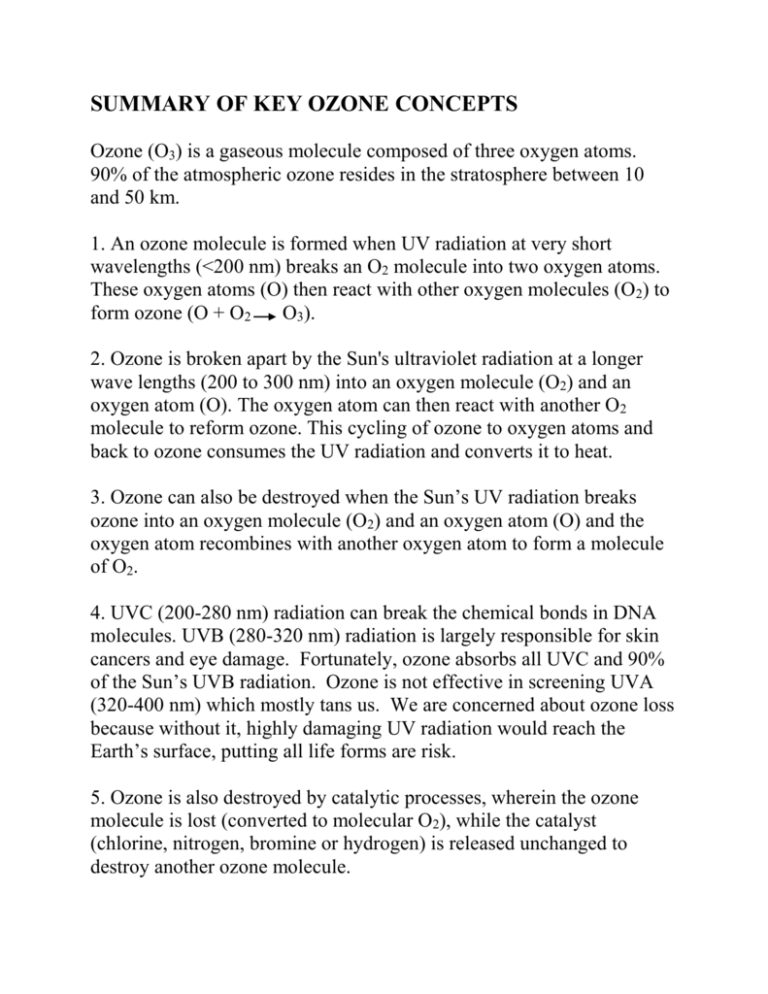
SUMMARY OF KEY OZONE CONCEPTS Ozone (O3) is a gaseous molecule composed of three oxygen atoms. 90% of the atmospheric ozone resides in the stratosphere between 10 and 50 km. 1. An ozone molecule is formed when UV radiation at very short wavelengths (<200 nm) breaks an O2 molecule into two oxygen atoms. These oxygen atoms (O) then react with other oxygen molecules (O2) to form ozone (O + O2 O3). 2. Ozone is broken apart by the Sun's ultraviolet radiation at a longer wave lengths (200 to 300 nm) into an oxygen molecule (O2) and an oxygen atom (O). The oxygen atom can then react with another O2 molecule to reform ozone. This cycling of ozone to oxygen atoms and back to ozone consumes the UV radiation and converts it to heat. 3. Ozone can also be destroyed when the Sun’s UV radiation breaks ozone into an oxygen molecule (O2) and an oxygen atom (O) and the oxygen atom recombines with another oxygen atom to form a molecule of O2. 4. UVC (200-280 nm) radiation can break the chemical bonds in DNA molecules. UVB (280-320 nm) radiation is largely responsible for skin cancers and eye damage. Fortunately, ozone absorbs all UVC and 90% of the Sun’s UVB radiation. Ozone is not effective in screening UVA (320-400 nm) which mostly tans us. We are concerned about ozone loss because without it, highly damaging UV radiation would reach the Earth’s surface, putting all life forms are risk. 5. Ozone is also destroyed by catalytic processes, wherein the ozone molecule is lost (converted to molecular O2), while the catalyst (chlorine, nitrogen, bromine or hydrogen) is released unchanged to destroy another ozone molecule. 6. Long-lived trace gases such as CFCs are lofted into the stratosphere from the tropical upper troposphere. After entering the stratosphere, the CFCs are typically transported into the midlatitudes and carried back out of the stratosphere. A small fraction of the CFCs are lofted into the upper stratosphere (above the ozone layer), where they are broken up by the Sun's extreme shortwave UV radiation, releasing the chlorine atoms that act as catalysts that cause ozone destruction. 7. The Antarctic ozone hole is directly a result of the human produced Chlorine-compounds that enter the stratosphere (principally CFCs). The hole appears each spring in the southern hemisphere (AugustNovember) over Antarctica following the extremely cold Antarctic winter. The hole results from chemical reactions that occur on the surface of polar stratospheric cloud (PSC) particles. These special reactions release chlorine from benign forms (HCl and ClONO2) into a form that can quickly catalytically destroy ozone. 8. Compounds such as CFCs that can cause ozone loss have now been regulated by international agreement. Chlorine compounds that can destroy ozone have begun to decrease in the lower atmosphere and are expected to start to decrease soon in the stratosphere, although their long residence times (decades to centuries) means it will be 50 years or more before ozone returns to its pre-industrial level. Future impacts on the stratosphere from aircraft and greenhouse gas effects are currently under investigation.




